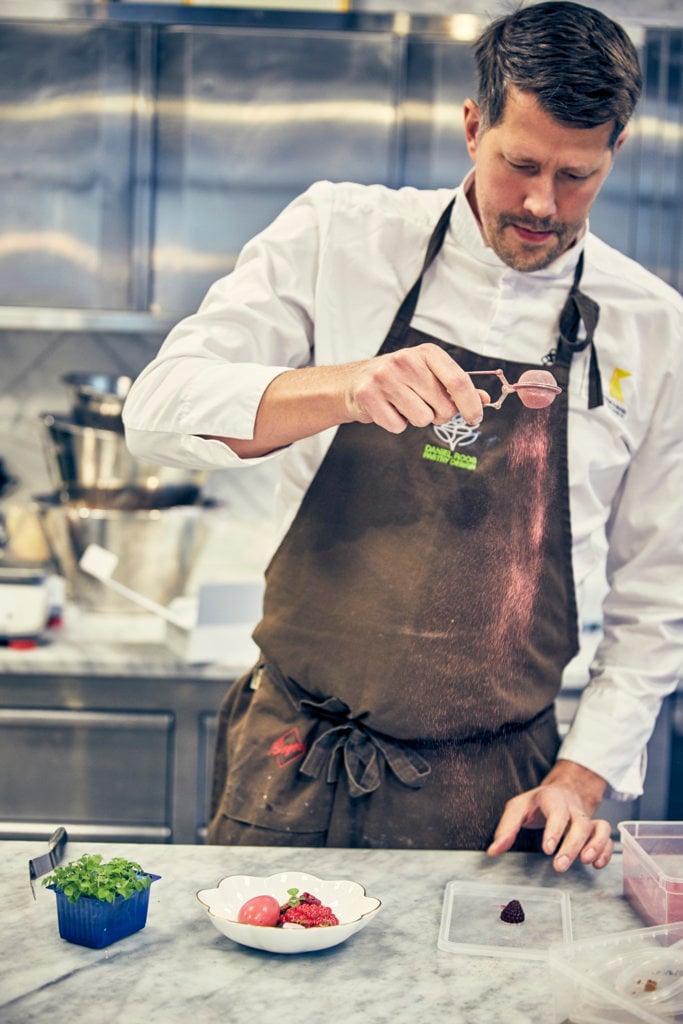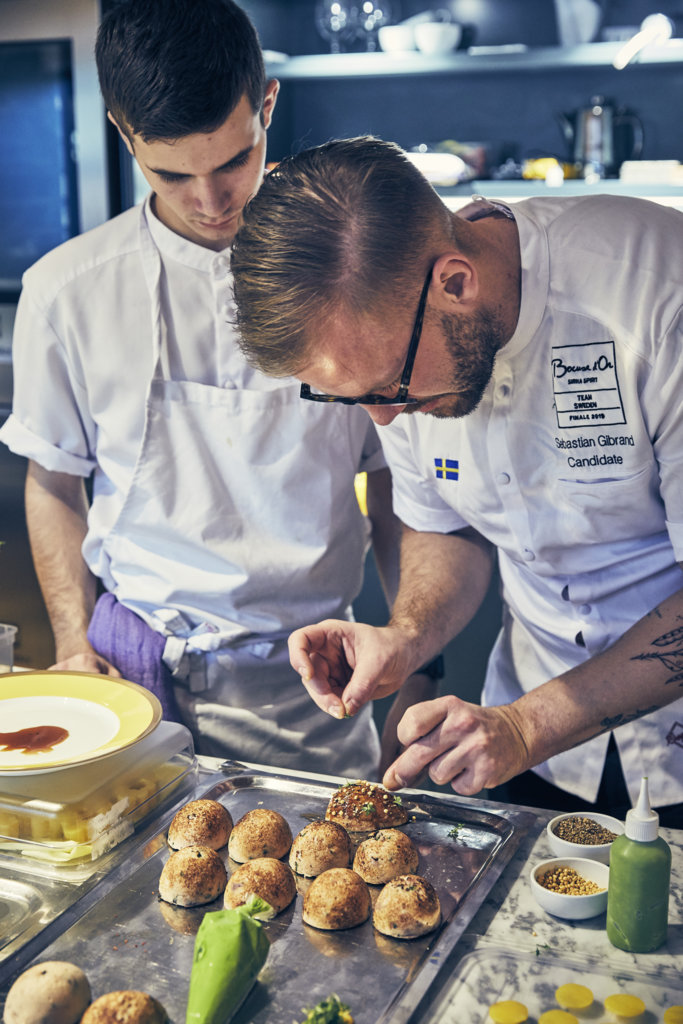“Ultimately, everything will be okay!”
Confectioner Daniel Roos says that creating the Nobel Prize banquet dessert for six consecutive years has not only made him a better confectioner – but has also taught him how to not panic even when things don’t go as planned.

© Nobel Media. Photo: Dan Lepp.
Roos is famous for creating desserts in beautiful shapes and forms, combining culinary elegance with flavours that more than satisfies a person’s taste buds. Roos himself says that while the richness of the taste and flavours of the dessert are always his number one priority, the presentation of the dessert is also crucial.
Roos made his first Nobel banquet dessert – a sensational combination of wild dewberries and saffron – in 2014 and since then Roos has been responsible for the dessert at the banquet for six consecutive years. This year he has made a dessert featuring his favourite berry – raspberry – and the ultimate dessert flavour: chocolate.
His second year as the Nobel banquet confectioner was his toughest. He quickly decided which flavours to use but was more unsure about how to create the dessert’s composition. Inspired by the shape of the Nobel Prize plate, he thought that he could make the dessert in the shape of a flower. He then decided to use a flower-shaped creation as the main center piece of the dessert. The flower can today be seen in many of his pastries as well as cakes.
To work with a center piece in a specific shape is how Daniel’s creative process starts. By first creating the centre piece, it is then possible to add different elements and slowly work on adding different layers of flavours as well as shapes. The centre piece of this year’s dessert is inspired by his three-year-old daughter’s toy. When playing with his daughter, he found a toy shaped as a pile of peas. The form felt very similar to the shape of a raspberry and shortly after the toy was used to create the center piece of this year’s banquet dessert.
The 2019 Nobel banquet dessert inspires a summer dream and features raspberries and chocolate. The raspberries were picked this summer at ‘Hallongården’ in the city of Trelleborg located in southern Sweden. Three hundred kilograms of raspberries were then individually frozen and ultimately used at the banquet in Stockholm, Sweden on 10 December 2019. Roos made sure to make the best use of all the raspberries, by even making a raspberry powder of the spillovers for his raspberry puree, sauce and crème.
“I am so honoured and happy that I get to do this. I want to perform so well that the Nobel Foundation don’t ask another confectioner to create the dessert next year! And yes, I will be a bit bitter if they don’t choose me next year as well,” jests Roos. “But I also understand that I can’t continue to create the Nobel dessert forever and one year will have to be my last.”
Roos’ pastries and cakes are available at his bakery and restaurant group, called K-märkt, in Stockhom, Sweden. If you are lucky, a pastry similar to the 2019 Nobel banquet dessert might be there for you to indulge.
Similar to Daniel Roos, this year’s chef, who is responsible for the starter and main dish, uses a variety of artistic shapes and forms when creating his dishes.
The 2019 Nobel banquet chef Sebastian Gibrand is well known for participating in – and often winning – international chef championships. He most recently represented Sweden in Bocuse d’Or and finished second in the final. He says that serving around 1,350 guests at the Nobel banquet can be considered competing against himself.

© Nobel Media. Photo: Dan Lepp.
Gibrand was born in a Swedish southern city called Helsingborg and his food is mostly based on Swedish produce. It’s apparent that he values locally-produced produce as he can name almost all of the farmers he collaborates with by name. “We have to highlight and put forward our Swedish commodities,” says Gibrand. He also, much like Roos, makes full use of the produce by using all spillovers for powders and decorations.
A guest at the 2019 Nobel Banquet will get a taste of Swedish cuisine: they’ll first be served a light and fresh starter featuring the Swedish delicacy kalix vendace roe, accompanied by cucumbers, kohlrabi, dill and horseradish. The main dish that follows offers flavours of Swedish duck, chanterelles, shiitake, king solo garlic, beetroot and potatoes. When it comes to the design, the starter makes the banquet guest think about this year’s physics prize and the solar system, whilst the main dish takes inspiration from the Swedish forest.
When creating the dishes, Gibrand constantly kept in mind that they were to be served to many guests. Subsequently, the dishes and cooking techniques were adopted to simplify the serving at Stockholm City Hall on 10 December. For example, he used a specially made baking tray filled with as many silicon forms as possible to speed up the baking process of the stuffed ducks. “I got some help with creating the silicon forms from my sister, who is an architect,” he tells us.
The banquet food was inspired by the dishes he competed with in Bocuse d’Or. Suitably enough, the Swedish team had chosen to make their competition contribution a tribute to the Nobel Prize as they felt that it was one of the best ways to represent Sweden. Therefore, the dishes feature numerous gold decorations, such as the small gold coloured crumbles on top of the stuffed duck. Gibrand also admits that his Norwegian competitor in Bocuse d’Or was kind enough to lend him a laser machine that simplifies the process of creating a perfectly shaped circle on the plate of the starter. Besides being inspired by his participation in Bocuse d’Or, he also says that he based these dishes simply on food he himself enjoys and indulges in. “For me, the process of serving someone food is like placing one’s heart and soul on a plate,” says Gibrand.
This is the first time Gibrand is responsible for creating the Nobel Prize banquet starter and main dish, and he is honoured by this assignment: “This is one of the most prestigious things you can do.” He has previously been part of preparing the 2014 Nobel Prize banquet food under the leadership of chef Klas Lindberg. That same year Roos did his first Nobel dessert.
This year Gibrand had 40 chefs under his leadership preparing the food for the 2019 Nobel banquet at Stockholm City Hall. When Gibrand first got the offer earlier this year he couldn’t help but think: “Seriously, are you really thinking clearly when you are thinking that I will be able to pull this off?!” In the end, Gibrand served a menu with culinary bravura. Together, Gibrand and Roos have created unforgettable culinary experiences for the 2019 Nobel Prize banquet guests.

© Nobel Media. Photo: Dan Lepp.